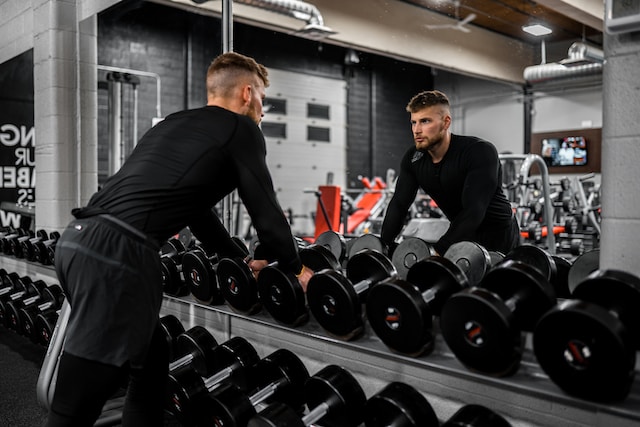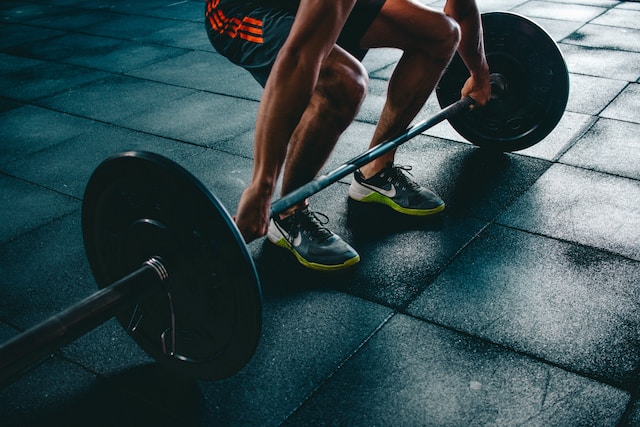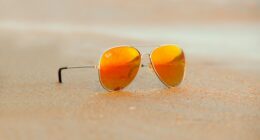Cutting is the process of losing fat while maintaining muscle mass, whereas bulking is the process of gaining muscle mass along with some fat. Cutting and bulking are two different approaches to achieving different goals in bodybuilding.
What is cutting?
(Photo by Andrew Valdivia on Unsplash )

Cutting is a term used in the fitness industry to describe the process of losing excess body fat while maintaining muscle mass. This strategy is often implemented by individuals who want to achieve a leaner, more defined physique.
During cutting, you will consume fewer calories than your body requires, creating an energy deficit that forces your body to burn fat for fuel. To achieve this calorie deficit, you can reduce your portion sizes and cut out high-calorie foods such as sugary drinks and snacks.
In addition to controlling your caloric intake, increasing physical activity through cardio exercises and strength training can help speed up the weight loss process during cutting. However, it’s important not to overdo it with exercise or cut too many calories too quickly as this could lead to muscle loss instead of just fat loss.
Cutting requires discipline and patience but when done correctly can result in a significant reduction in body fat percentage which leads to better overall health and physique aesthetics.
What is bulking?
(Photo by Anastase Maragos on Unsplash )

Bulking is a term used in the fitness industry that refers to a specific phase of training where an individual aims to gain muscle mass. This process involves eating excess calories and lifting weights with high volume and intensity. The goal is to put on as much muscle as possible without worrying about gaining fat.
During bulking, individuals typically consume more protein, carbohydrates, and healthy fats than they would during their regular diet. These macronutrients provide the body with the necessary fuel for intense workouts and help promote muscle growth.
In order for bulking to be effective, it’s important to track progress regularly by taking measurements or photos. This helps ensure that weight gain is primarily due to muscle mass rather than fat accumulation.
While bulking can result in significant gains in strength and size, it’s not necessarily suitable for everyone. Individuals who are already overweight or have health conditions such as diabetes should consult with a doctor before embarking on a bulk cycle.
Bulking requires discipline and consistency both in terms of nutrition intake and exercise routine. With dedication and adherence to proper techniques, individuals can see impressive results during this stage of training.
Cutting Vs. Bulking – Key differences
When it comes to fitness, two terms that are commonly used are cutting and bulking. Both of these terms describe different phases in a workout routine. Cutting is the phase where you aim to lose body fat while maintaining muscle mass, whereas bulking involves gaining weight and muscle mass through a caloric surplus.
The main difference between cutting and bulking is the goal. While cutting aims to reduce body fat percentage, bulking focuses on increasing muscle mass. This means that during a bulk, you will be consuming more calories than your body needs in order to build muscle.
Another key difference between cutting and bulking is the type of exercises performed. During a cut, cardio exercises such as running or cycling may be incorporated into your routine alongside resistance training workouts with lighter weights but higher reps. In contrast, during a bulk phase heavier weights with lower reps can be used along with compound movements like squats or deadlifts for maximum gains.
Nutrition plays an important role in both phases of fitness. During a cut phase high protein low-fat foods are preferred which includes lean meats like chicken breast or turkey breast also vegetables like spinach or broccoli etc., whereas during a bulk phase carb-heavy meals can help fuel intense workouts along with sufficient amounts of protein from meat sources or supplement shakes for building muscles.
Understanding these differences between cutting and bulking can help you create an effective workout plan tailored towards your own goals!
How to bulk and cut effectively
To bulk effectively, it’s important to consume more calories than you burn. However, this doesn’t mean you should just eat whatever junk food is available. Focus on consuming nutrient-dense foods like lean proteins and complex carbohydrates.
In addition to your diet, strength training is essential for building muscle mass during a bulk. Aim for heavy lifting with fewer reps and sets to promote muscle growth.
When it comes to cutting, the focus shifts from consuming excess calories to creating a calorie deficit by burning more calories than you consume. This can be achieved through cardio exercises and reducing caloric intake while maintaining protein levels.
While cutting, it’s important not to cut too drastically as this could result in muscle loss along with fat loss. Gradual cuts of around 500 calories per day are recommended.
It’s also crucial that both bulking and cutting phases are approached gradually rather than jumping into extreme changes all at once. Gradual adjustments allow for better adaptation by the body over time resulting in long-term success.
Should I bulk or cut first?
When it comes to deciding whether to bulk or cut first, there is no one right answer. It ultimately depends on your personal goals and body composition.
If you have a high body fat percentage, starting with a cutting phase may be beneficial in order to decrease excess fat before attempting to build muscle mass. On the other hand, if you are already lean but lack muscle definition, bulking first could help increase overall muscle mass which will make future cutting phases more effective.
It’s important to consider your long-term goals when deciding which approach to take. If your ultimate goal is weight loss and increased definition, starting with a cutting phase may be best for you. However, if you’re looking for significant muscle gains over time, beginning with a bulking phase can help set the foundation for that progress.
Regardless of your decision, it’s important to remember that both phases require dedication and consistency in terms of nutrition and training in order to see results.
Is it harder to cut or bulk?
One of the most common questions asked by people who are looking to transform their body is whether it’s harder to cut or bulk. The answer may vary depending on a person’s individual goals and circumstances.
When it comes to bulking, the difficulty lies in consistently consuming a surplus of calories while engaging in regular strength training. This can be challenging for those who struggle to eat enough or have a naturally fast metabolism.
On the other hand, cutting involves creating a calorie deficit through diet and exercise which can be mentally and physically demanding. Sticking to a strict meal plan and pushing through intense workouts can take a toll on one’s motivation and energy levels.
Ultimately, both bulking and cutting require discipline, consistency, and patience. It may be harder for some individuals than others depending on factors such as genetics, lifestyle habits, and personal preferences.
Regardless of which phase you choose to focus on first, remember that progress takes time. Stay committed to your goals with realistic expectations in mind, celebrate small victories along the way, and always listen closely your body’s needs throughout any transformation process.
What food to eat while cutting?
When it comes to cutting, one of the most important things is to maintain a calorie deficit. This means burning more calories than you consume. To achieve this, you need to focus on eating foods that are nutrient-dense and low in calories.
Firstly, protein should be your best friend while cutting as it keeps you satiated for longer periods of time and helps with muscle preservation. So incorporate lean sources of protein such as chicken breast, turkey breast or fish into your diet.
Secondly, consuming fibrous vegetables like broccoli, spinach and kale can also help fill up your stomach without adding many extra calories. These greens provide essential nutrients like vitamins A and C which will keep your immune system healthy throughout the process.
Thirdly, complex carbohydrates are an important part of any healthy diet but during a cut they should be consumed in moderation. Opt for sweet potatoes instead of white potatoes or choose quinoa over pasta.
Don’t forget about fats! Consuming good fats found in avocados or nuts can actually boost weight loss efforts by improving insulin sensitivity and speeding up metabolism.
Sticking to whole foods that are low in calories but high in nutrition is key when it comes to food choices while cutting.
Featured Image By – Victor Freitas on Unsplash








